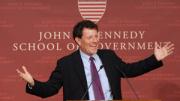"What applications might they suggest, William A. Sahlman asked his students, for 'electronic ink'--particles and dyes, embedded in a surface, that could be charged to form changing texts without the bother of paper and printing? The class snapped to attention, and a swarm of ideas buzzed down from the semicircular banks of seats in Aldrich 9. Price tags (retailers wouldn't have to re-mark them for discounted sales). Billboards. Sheet music (self-turning scores). Eyeglasses with news headlines projected inside the lens (prompting Sahlman to interject, 'So, as you're purportedly watching me...'). Newspapers with built-in refreshable video. Menus (no more regrets from the waiter that the daily special is sold out). Maps. Camouflage clothing that changes in different lighting (Sahlman again: 'So if you hadn't read the case and wanted to disappear...')."
That account, from a 2001 Harvard Magazine article, "Who Wants to be an Entrepreneur?", may seem like archaeology, but it is in fact an early unveiling of the E-Ink company (founded in 1997) and technology that have become increasingly popular with the spread of Amazon's Kindle, the electronic-book device. (On the company's visionary then-chairman, Jerome Rubin '44, G '46, LL.B '49, who imagined electronic newspaper delivery, see here.)
The discussion reported in the article featured an elective course, "Entrepreneurial Finance," taught by the Business School's William A. Sahlman, who is D'Arbeloff - MBA Class of 1955 professor of business administration (and now also a senior associate dean; for more on his research and teaching, see here). The d'Arbeloff Chair was established in 1986 to support teaching and research on the entrepreneurial process.
During the class discussion, Russell J. Wilcox '89, M.B.A. '95, co-founder of E Ink and then its vice president and general manager, joined in, and, as the article reported, explained "how the company planned to sell as an initial product a wireless network of billboards and displays. National retailers like Wal-Mart and J.C. Penney could assure uniform signage throughout their stores, and could change prices without printing and shipping paper signs--and hoping store managers posted them. He acknowledged that the scientists, who are driven by discovery, aren't much moved by selling sneakers. But in one essential way they supported the company's strategy of having 'our eyes in the sky but our feet on the ground,' Wilcox said. 'Scientists aren't less greedy than other people'--they realized that retail displays were a first step, followed by entry into the capital-intensive, highly competitive market for flat-panel displays, in order to raise the money needed to develop the holy grail of 'radio paper.' Reaching that frontier, and a potentially huge market, was perhaps $200 million of research spending in the future," Wilcox forecast.
Unlike many other start-ups that suffered an early death, it appears Wilcox was spot-on about his firm's prospects: the Kindle has validated E-Ink's technology, and the company--billing itself the leader in "electronic paper displays," agreed on June 1 to be acquired by Prime View International, its largest customer, for $215 million. Wilcox is chief executive. For more on E-Ink and the deal, see here.








